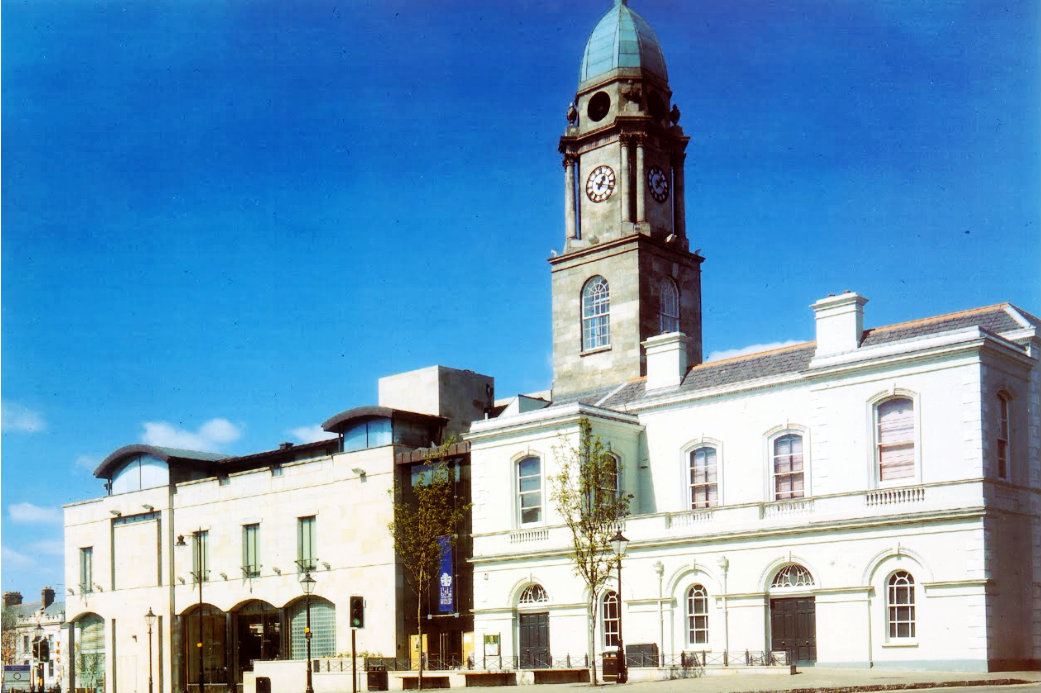Irish Linen Centre & Lisburn Museum, United Kingdom


Lisburn Museum was established in 1979. Originally focusing on displays and exhibitions relating to the rich history of Lisburn and the wider Lagan Valley, the museum expanded in 1994 with the opening of the award-winning Irish Linen Centre. The museum takes advantage of Lisburn’s long association with Ireland’s linen industry. The Museum aims to collect, safeguard and interpret artefacts and information relating to the Irish linen industry and the history of Lisburn and the Lagan Valley.
The Irish Linen Centre & Lisburn Museum’s galleries features a range of temporary and visiting exhibitions, featuring: the history of Lisburn, and its people; local artists, from Blackshaw to Mcloy; textile and linen display; local poets, writers and personalities.
The Irish Linen Centre & Lisburn Museum sits in Market Square, the historic centre of Lisburn. Market Square, then known as Market Place, was laid out in the 1620s. By the 1630s Lisnagarvey (Lisburn’s name prior to 1661) had over 250 inhabitants, and a weekly market, and the Market House – the home of Lisburn Museum – was constructed.
The Market House
The museum is located in the old Market House. Here, under the red sandstone arches, linen cloth was sold. Dating from the mid-17th century, the Market House was the only building in Market Square to survive the great fire of Lisburn in 1707.
In the 1700s a first floor was added to the Market House. The clock tower was constructed in 1808, and the 19th-century facade was completed in 1889 by Sir Richard Wallace, local landlord and the renowned art patron.
The Assembly Rooms
The Assembly Rooms on the first floor was a meeting point for soirees, balls, dance classes and political meetings throughout the 18th and 19th centuries. They are today available to rent for private events.
The Assembly Rooms continues to be used as an important civic space, hosting museum events, lectures, workshops and exhibitions.
Collections and Research
The museum collects material relating to Lisburn and the Lagan Valley, as well as the Irish Linen Industry.
As well as holding the reference library for the Linen Industry Research Association, or LIRA, the museum’s own library contains a range of resources, including books relating to Irish Linen, Lisburn, art, art history, Irish history and textiles, as well as local newspapers, journals, microfilms, photographs and audio-visual material.
Education Services
The museum offers free tailored programmes, tours and workshop for all ages, from arts and crafts to linen, Castle Gardens to Town Trails, WWI to costumed 17th-century talks.
The Galleries
The museum has a number of galleries, where it hosts its own temporary exhibitions on local subjects, including history and art, as well as photographic or travelling exhibitions.
The Irish Linen Centre & Lisburn Museum’s award-winning permanent exhibition tells the story of linen, with expert guides and live spinning and weaving demonstrations.
Weaving Workshop
Here, our expert weavers give live demonstrations of the hand loom, or weave damask on the innovate Jacquard loom.
The Factory Floor
Life in a linen factory in the 19th and 20th centuries is explored on the Factory Floor.
Castle Gardens
From the museum it is only a short walk to Castle Gardens. This is the site of Lisburn Castle, the Conway family’s 17th-century manor house. The original castle is no longer standing, but part of the walls and the impressive 17th-century terrace, including the gazebo and bakery, remain.
The gardens also contain a monument to Sir Richard Wallace, local MP, landowner and successor to the Conway’s, whose collection of art and that of his father’s, the 4th Marquess of Hertford, largely makes up the world-famous Wallace Collection.
Castle Gardens is home to one of the town’s cast-iron Wallace Fountains. These distinctive green drinking fountains can be found all over the world, and were originally gifted to the people of Paris by Sir Richard Wallace, following the Franco-Prussian War in 1871.
Lisburn’s Industrial Past on the Lagan
Castle Gardens affords a panoramic view of much of Lisburn and the wider Lagan Valley, and it is possible to pick out remnants of the region’s industrial past. Just east of the Gardens, for example, lies the former site of the Vitriol chemical works (c.1760-c.1840) and later the Island Spinning Company Ltd (1867-1983), responsible for flax spinning and thread making. The island, bounded by the River Lagan in the north and the canal in the south, is now occupied by Lisburn & Castlereagh City Council , but the lock, through which over 180, 000 tons of linen, coal and dry goods travelled every year, remains.